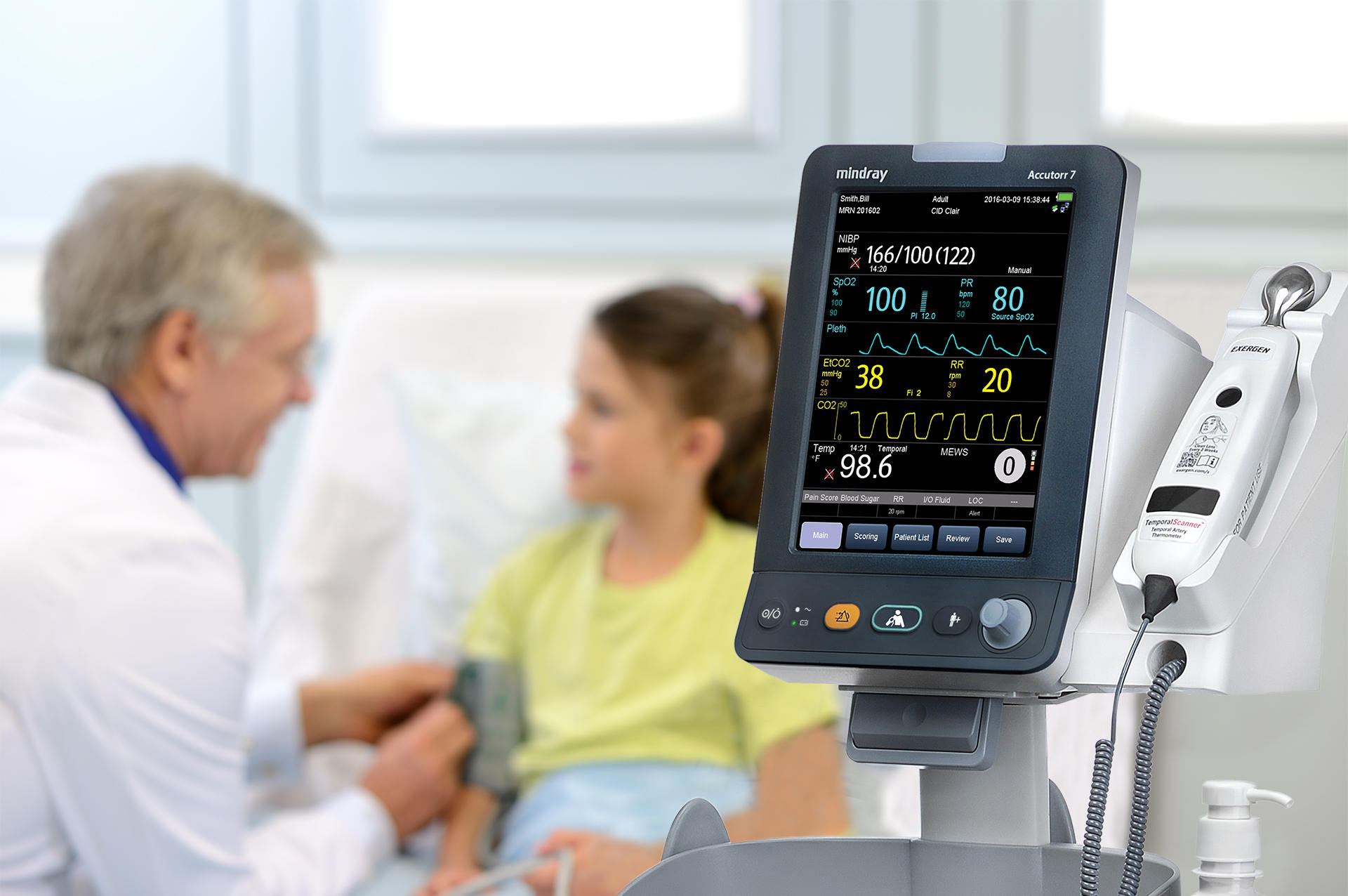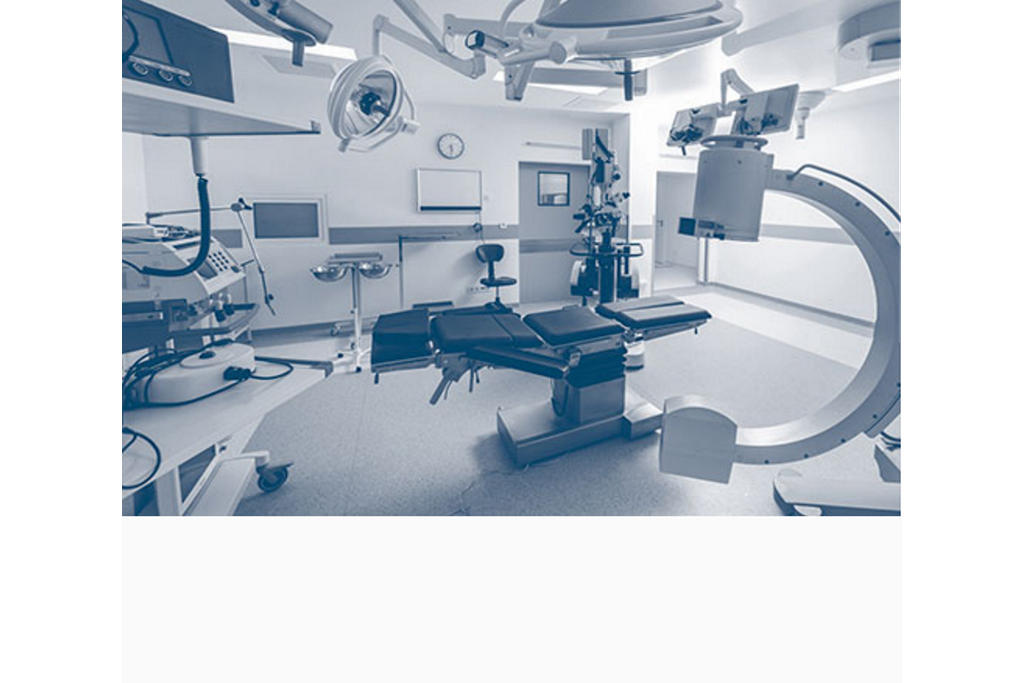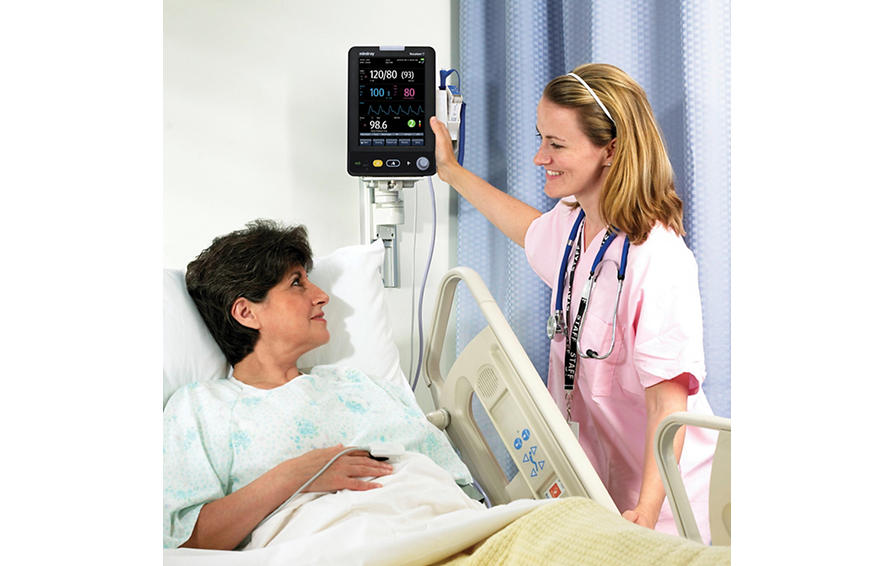Vital signs monitors are essential devices used by healthcare professionals to evaluate the overall health of a patient. Typically, a vital signs monitor records a patient’s:
- Blood pressure
- Pulse rate
- Oxygen saturation levels
- Body temperature
- Respiratory rate
Vital signs monitors enable clinicians to evaluate their patients in or outside a hospital setting quickly and efficiently. Seymour B. London, an American physician, designed the first automatic blood pressure monitor, and his device helped usher in the modern vital signs monitor.
Today, vital signs monitors are portable devices with wireless capabilities. They collect a patient’s real-time data, help healthcare professionals identify signs of patient deterioration, and reduce manual errors by automatically sending data to the electronic medical record. Vital signs monitors are largely used to perform routine spot-check monitoring, and in some instances, are relied on for basic continuous bedside monitoring.
The device’s sensors can be clipped to a patient’s fingers or patched to the skin. The sensors deliver information to the monitoring device when connected to a patient. A vital signs monitor operating in continuous mode gives clinicians a full picture of their patient’s health from the time they are set up on the monitor until they are removed from the monitor. The monitor will send a signal – either a beeping sound or flashing lights – if a patient’s vital signs fall outside healthy levels, indicating the patient may need medical attention. However, sometimes the warning signal could also mean the sensor isn’t getting any information. For instance, the sensor detached from the patient.

Spot-check mode monitors, the most commonly used mode for vital signs monitors, periodically monitoring a patient’s vital signs. These devices are used to take a single set of vitals from a patient at any given time.
How Clinicians Assess a Patient’s Vital Signs
Blood Pressure
When the heart beats, pressure is applied to the walls of the large vessels as blood travels through the body. Blood pressure measures the force applied to the body’s arteries.
When measuring a patient’s blood pressure, doctors consider two different numbers: systolic and diastolic.
Systolic is the top number of the blood pressure reading on the vital signs monitor. Systolic blood pressure is measured when the heart contracts and pumps blood through the body.
Diastolic is the bottom number of the blood pressure reading on the vital signs monitor. Diastolic blood pressure is measured when the heart relaxes, and the ventricles can refill with blood.
The average systolic pressure of an adult should measure between 100 and 130, and diastolic pressure should measure between 60 and 80.
Pulse Rate
According to the American Heart Association, the heart of a healthy adult beats 60 to 100 times per minute. The heart rate of a highly active person can usually beat as low as 40 times per minute.
Healthcare professionals also measure heart rate as pulse rate (PR). The number that indicates a patient’s pulse rate is displayed in the PR box of the vital signs monitor. Here is a hypothetical example. The pulse rate for a 60-year-old with a heart valve issue should read between 60 and 100 if the patient has been resting in bed. If the patient got up and walked to use the restroom, that number would be larger. Any number higher than 100 displayed on the monitoring device for this particular patient would indicate too much pressure on the arteries for a person with one or more heart valves not functioning correctly.
Oxygen Saturation Levels
Oxygen saturation levels measure oxygen concentration in a patient’s blood on a scale up to 100 (percent saturation). The target range should be between 95 and 100. When doctors measure the oxygen saturation levels in a patient, they read the number on the screen as a percentage. If the number reaches below 90, this indicates that a patient is not receiving enough oxygen. Doctors record the patient’s blood oxygen level in the vital signs monitor’s SpO2 (oxygen saturation) box.
Body Temperature
The average body temperature of a patient can range between 97.8 ° and 99.1° Fahrenheit. The average body temperature is 98.6° Fahrenheit. On a vital signs monitor; the patient’s temperature will display under the section labeled TEMP. For example, if a 40-year-old patient’s body temperature reads 101.1° Fahrenheit in the TEMP box, they have a fever. Body temperature below 95° Fahrenheit indicates hypothermia. Temperature can vary in a patient based on several factors such as gender, hydration, time of day, and stress. Younger people control body temperature better than older people. Older patients may be ill without displaying signs of a fever.
Respiratory Rate
A patient’s respiratory rate is the number of breaths they take per minute. The average respiration rate for an adult at rest is 12 to 16 breaths per minute. The patient’s respiration rate is displayed in the RR box of the vital signs monitor. If a patient’s respiratory rate is under 12 or over 25 breaths per minute while they lay in bed, doctors consider their breathing abnormal. Several conditions can change the regular respiratory rate in a patient, including anxiety and heart failure. For example, if the clinician sees a 20 in the RR section of the vital signs monitor, this may indicate the patient is experiencing distress potentially caused by pain or anxiety.

The Significance of the Vital Signs Monitor
Healthcare facilities rely on vital signs devices to measure the general physical health of a patient. Vital sign measurements provide medical professionals with clues to potential health issues and help them track a patient’s progress towards recovery. The primary function of a vital signs monitor is to alert medical staff when a patient’s vitals dip below established, safe levels. For this reason, vital signs machines are valuable medical devices that help doctors save people’s lives.If you are looking to purchase a vital signs monitor, please visit: https://www.mindray.com/na//products/patient-monitoring/vital-signs-monitors/ to learn more about the vital signs monitors Mindray North America offers or contact us at 201.995.8000.
References:
[1] Mayo Clinic.com: Blood pressure chart: What your reading means
[2] WebMD.com: Diastole vs. Systole: Know Your Blood Pressure Numbers
[3] American Heart Association: All About Heart Rate
[4] Seymour London: Inventor of automatic blood pressure monitor




